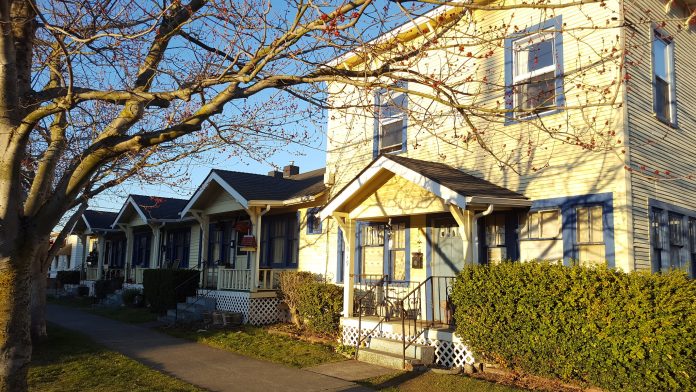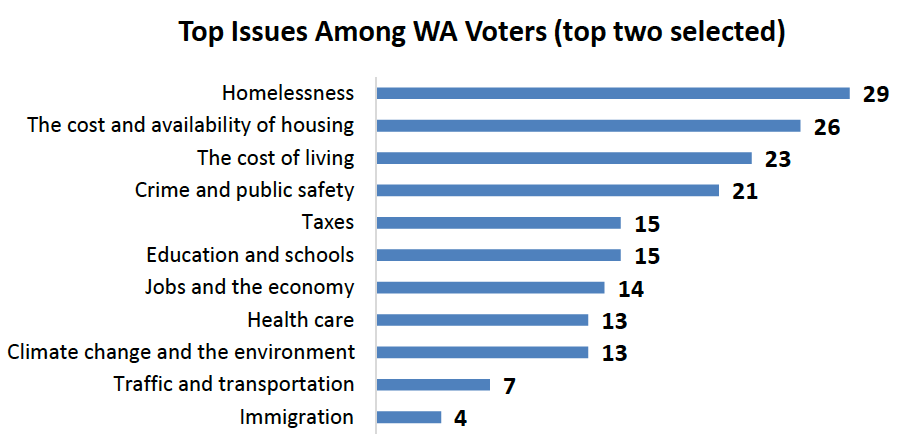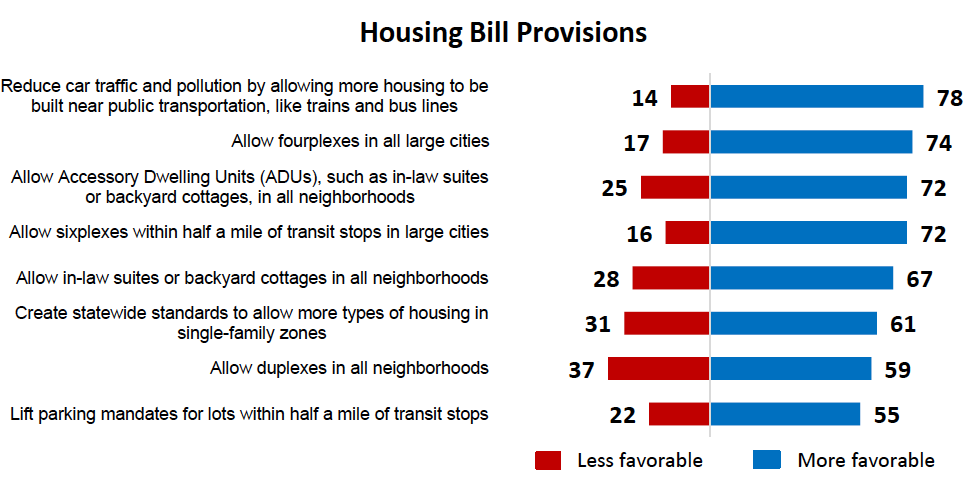
More than 60% of likely Washington voters indicated they were supportive of legislation to increase production of missing middle housing across the state in a recent poll completed for the Sightline Institute by Lake Research Partners. The poll results come at a moment in which missing middle housing legislation is a hot topic in both the Washington State House and Senate. The House passed a watered down version of the original HB 1782 bill out of committee on Tuesday, while debate on the bill continues in the Senate.
As the details get worked out, lawmakers would be wise to take into account poll data indicating a strong majority of Washingtonians are greatly concerned by statewide housing affordability crisis and see increasing the production of missing middle housing as a possible solution.
Much criticism of the missing middle housing legislation has been aimed at the fact that it takes a statewide approach, as opposed to the incentives for increasing density offered by HB 1923, which was enacted into law in 2019. However, Sightline’s poll found that over two-thirds of respondents (68%) agreed the statement that “the housing crisis spans municipal borders and is too big for cities to tackle alone, which is why we need statewide affordability solutions.” While voters identifying as Democrats (87% in favor) or independents (62% in favor) were likeliest to favor statewide housing affordability solutions, nearly half of Republicans (47%) were also in agreement, a finding that may sway lawmakers who represent swing districts with high numbers of moderate and conservative constituents
Lake Research Partners interviewed 600 likely voters in Washington with an oversample of 150 voters of color for the poll. The interviews were conducted by telephone and text-to-online interview from January 13-19, 2002 and margin of error for the poll is assessed to be +/- 4.0%.
Across the state, respondents assessed the housing situation as “very serious”
When asked to name the two most pressing challenges facing Washington State today, the polled voters selected three housing-related issues as their most significant concerns. Homelessness came out on top with 29% of voters polled naming it as the state’s most important problem, followed closely by cost and availability of housing (26%), and the cost of living (23%).

Overall, when asked to rate the severity of the housing situation in Washington State on a 1-10 scale, 74% of poll participants judged it as a serious problem, awarding it a score of 6-10, and of that group 22% rated it as a “crisis” (10). The assessment crossed political party lines with 84% of Democrats, 74% of independents, and 57% of Republicans naming it as a problem. While much has been made of housing affordability woes in the western half of the state, roughly three-quarters of residents in all regions of Washington rated the housing situation as a serious problem. The northeastern corner of Washington was the sole outlier with 59% of polled residents rating the housing situation as a serious problem, not exactly a steep drop-off. While much of northeastern Washington is rural and sparsely populated, the Spokane metropolitan area has more than half a million people in it, and housing prices are skyrocketing here as elsewhere in the state. In fact, average home values in Spokane are up 28% in just one year, according to Zillow’s index.
When it came to judging the primary housing issues in their own community, respondents were most likely to rate the high cost price of buying housing and expensive rental costs as the primary problems, followed by housing scarcity and homelessness. The poll also asked respondents to assess whether or not the state housing situation had personally impacted them. Republicans were the least likely to to respond that it directly impacts them, although numbers were not that much lower than those select by Democrats and independents. As a whole, respondents were slightly more likely to express that while a problem, the housing situation had not impacted them. This may be because about 60% of the voters polled identified as homeowners.
Support for a statewide zoning law
To test out the popularity of statewide legislation, the pollsters created an example missing middle zoning law and presented it to the poll participants. As mentioned earlier, the zoning law was popular with 61% of respondents expressing support and 41% of respondents express “strong support.”
While the example zoning law bears resemblance to legislation currently under consideration by the state legislature, it is worth noting that most of its provisions are a closer to match to the current state of HB 1782 than its original, more ambitious version, which would have authorized sixplexes instead of fourplexes within a half-mile of major transit stops in cities of 20,000 residents or more. Specifically, when describing the zoning law the text read:
This bill would change state law and zoning requirements to allow more homes like duplexes, fourplexes, and townhouses, including housing more affordable for lower- and middle-income families, near public transit lines, and in areas with a lot of jobs.
Credit: Lake Research Partners
But given the relatively vague language in the zoning law description, it might be more telling that specific provisions outlined in the poll were very popular when presented individually. The Urbanist has recently been banging the drum in favor of more ambitious in our transit oriented development, especially near major transit investments like the expansion of Link light rail to the Eastside, and the poll backs up the idea most Washingtonians are on board. A strong 78% stated they would feel more favorable about the zoning law if it were to reduce car traffic and pollution by allowing more housing to built near public transportation. Provisions to allow backyard cottages and fourplexes in all large cities were also very popular, with each polling over 70%. As a whole, each of the individual bill provisions polled at above 50%, and even the provision to allow duplexes in all neighborhoods, which registered the strongest disagreement at 37%, had a solid 59% of those polled indicating support.
In addition to most of the voters polled indicating that they were homeowners, they were also most likely to live in a suburb near a city, followed by a city, or more distantly by a small town or rural area. A majority of polled likely voters also identified as White and over the age of 30, with a strong contingent of those polled identifying as age 50 and older. In terms of education, most voters identified as having at least some post-secondary education and the largest single group identified as holding a four-year degree or equivalent.
With results so compellingly in favor of taking action to address Washington’s housing affordability crisis by allowing for more zoning for missing middle housing, lawmakers who’ve been leading the charge to take action for affordable housing should take heart that an increasing body of evidence shows Washingtonians are right there with them. Now is the moment to be bold for affordability.
Sign The Urbanist’s #Homes4WA petition backing missing middle housing.
Natalie Bicknell Argerious (she/her) is a reporter and podcast host at The Urbanist. She previously served as managing editor. A passionate urban explorer since childhood, she loves learning how to make cities more inclusive, vibrant, and environmentally resilient. You can often find her wandering around Seattle's Central District and Capitol Hill with her dogs and cat. Email her at natalie [at] theurbanist [dot] org.




